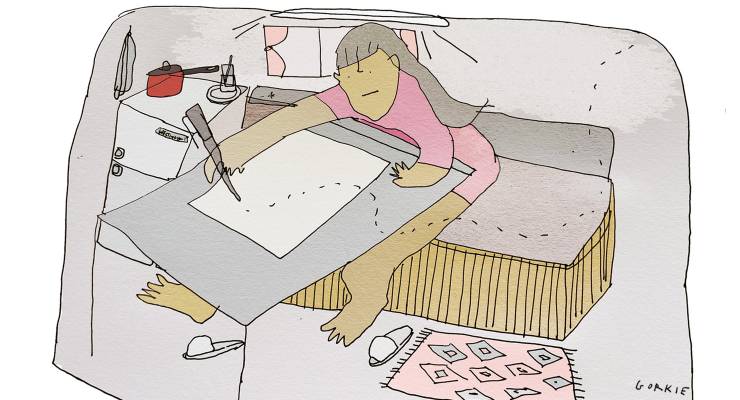
“Why do we live in a van?” asks Romanian journalist Elena Stancu of her unusual now decade-long lifestyle choice. “So we can be journalists, doing the sort of journalism that matters, documenting long-term subjects that rarely attract funding… extreme poverty, racism, school dropout, prisons, domestic violence, hospitals — and emigration.”
It’s a response that’s part business model (how do we pay for journalism?) and part journalistic practice: how do journalists report the current wave of global mass movement of peoples from the outside in?
Stancu and her photographer partner Cosmin Bumbuț figured the only way they could report (and afford to report) the big inside story of the mass emigration of 20% of working-age Romanians was to join them on the road, living and working across Europe in a six-metre-long van.
“In our van, any border between our work and our private lives is erased,” Stancu says. “We are our subjects, our articles. We spend more time living the lives of the people we document than our own. We park outside their homes or the lodgings in the strawberry fields; we are with them when they wake up, when they go to work, when they chat with their children on WhatsApp or when they have dinner.”
On their website Teleleu.eu and in the biggest Romanian daily, Libertatea, they capture the migrant experience. The push and pull of home, the risks of getting — and living — away, the joys and the pain of carving out a new life that holds both the old and new in their hands, through the stories of people like Eugenia, a care worker in southern Italy, or Cristian, a lorry-driver in the English midlands, or Oana, picking vegetables in southern Germany while her daughter Lucia grows up with her grandmother back in Romania.
World Press Photo winner Cesar Dezfuli has been using the inherent humanisation of photography to tell the story of the people caught in the migration route across the central Mediterranean through his ongoing project, Passengers.
He started with a head-and-shoulders gallery of 118 people photographed as they were rescued in August 2016 after they’d been found floating in a rubber boat 20 kilometres off Libya.
The power of the pictures comes from the frame-by-frame portrayal of young men, as they boarded the rescue boat, still in the T-shirts or open-neck shirts they travelled in, with only the blue sea stretching out behind them to the horizon. Call it the Instagram effect: the repetition and rawness of the moment wrench us inside the migrant reality far more powerfully than the edited and curated selections that we pass over as they illustrate daily news grabs.
One of his shots, of then-16-year-old Amadou Sumaila from Mali, won the 2017 Portrait Prize at Australia’s Head On Festival and was displayed at the Museum of Sydney.
Dezfuli has stayed on the story: the year after the Sydney showing, he started to track down the 118 men. Starting with a single Facebook contact, he searched the web of social networks to find them spread across Italy, France and Germany. He documented their stories in their own voices and photographed their new lives and now, the before and after shots form the latest iteration of the work circulated through public showings.
Much of our domestic reporting about migration is shaped by the ethno-nationalist populist kick-back — from our own Tampa moment, through Brexit and Europe’s 2016 migration crisis and onto Trump and America’s internal culture wars over the southern border.
Yet, in Latin America, most of the movement of people is happening internally as people find themselves pushed by domestic crises — from Nicaragua into Costa Rica, from Guatemala into Mexico and, most dramatically, from Venezuela into Colombia.
It’s through journalism-focused not-for-profit foundations that they’re finding a voice. Invisibles.info (in both English and Spanish) uses migration as one of its four themes to tell the narrative of organised crime, while Conexion Migrante writes from the many different perspectives of migrants in, from and to Mexico.
One recent report looked back at the experiences of undocumented Mexican migrants in New York in the midst of the pandemic. Another looked at the challenges of sexual abuse and health care for migrant women inside Mexico itself.
The migration story is often internal. In India, New Yorker writer Katherine Boo applied the empathic tools of fiction to write the remarkable prize-winning non-fiction book Behind the Beautiful Forevers about a Mumbai migrant community.
The Wire asked “Who Are They?” about India’s urban migrant workers forced to walk across the country to their homes in the early days of the COVID pandemic. Eighteen months later, Cannes Prize-winning documentary journalists Shirley Abraham and Amit Madheshiya covered the extraordinary exodus in The Great Abandonment.
While around the world, journalists are finding new perspectives for telling the migrant story from the inside, Australian journalism remains mired in the post-Tampa Canberra political news cycle. It’s time to think ourselves inside the story.
Do you think that Australian journalists lack empathy when reporting on issues of migration? Let us know by writing to letters@crikey.com.au. Please include your full name to be considered for publication. We reserve the right to edit for length and clarity.








I would say ignorance and the purveying of cliche is the mainstay of Australian journalism, particularly when it comes to writing about the Australian migration program. I see it time and time again, where the one perspective that is not covered or understood by journos is that of the visa applicant, particularly those from poorer third world countries (who also happen to be non-white) who are not treated at all equally by the system.
I am not even talking about humanitarian visas with all of its vicissitudes and collective punishments but people applying for ordinary average Visitor visas, employer sponsored visa, Skilled visas, partner visas, and just about any other visa.
The last group to be consulted or have their views or experience analysed or publicly ventilated by journalists are visa applicants.
Everyone else, including exploitative employers moaning about the fake skills shortage of waiters, aged care workers, and agricultural workers etc. to whom they will not pay a market clearing rate; education institutions with access to rivers of gold; liberal leaning professional associates who have made millions of dollars in assessing the qualifications of applicants; the regional lobby; and the Machiavellian Government have their stories told. They have armies of PR professionals and social media experts and marketing specialists to work with journalists to tell their stories.
As a migration agent, I see it time and time again, the outrage of the Australian family member when it dawns on them how dysfunctional the system is as they try and help a family member through the maze. Journalists may give a human face to a story from time to time but lack the training and rigour to understand how the system works to look at the collective experience of applicants.
From the perspective of the applicant and the much-maligned migration agent the system is a chaotic unfair unlawful lottery. If you do not believe me, go and apply for a visa yourself!
Good comment, most Australian seem to think we have open borders and anyone can wander in and overpopulate the place, right up till the day a friend or relative starts dealing with immigration, then they hear about barriers, dodgy treatment, even inhumanity….
Our RW ‘medium’ focuses simplistically to avoid local causes, like other policy areas, but does use headline visa, immigration of pop data that is neither analysed nor presented optimally, thanks to most having no skills of data, maths and science literacies, nor lived experience; or worse it’s good for a dog whistling headline.
Our hacks know their audience like the back of their knuckles – they’ve been feeding their staple diet to reinforce those prejudices for decades.
There’s no room for a variation of diet to include embarrassing challenges to held (voter) beliefs. That wouldn’t sell … ad space.
No. Better to reinforce long-held punter ideology – to nurture belief in pre-set righteousness – no matter how long-term a negative.
Exactly; any actual journalism in the MSM is a short-lived exception to the rule.
…I assume; I haven’t been able to bear exposing myself to it for years. Can’t even stand ABC any more
It would be good to hear more migrant stories; the ABC website quite often features stories about temporary migrants who can’t get a permanent visa for one reason or another, but that’s about all. However in Australia there are really no equivalents to migration within the EU, or from country to city in India.
The headline ‘Australian journalists need to do better when it comes to reporting on migration’ should read: Australian journalists need to improve their reporting of migration.
Since the late ’90s, before which Oz had quite a ‘cool’ brand, the public narratives via media (like renewable energy sources) have largely disappeared anything positive on post 1970s immigrants, asylum seekers, ‘immigrants’, international students, inflationary NOM net overseas migration & population growth (via temporary churn); while most media reflect the ‘skip’ nature of both parties, especially LNP.
An example was an esteemed senior journalist, allegedly centre or left, several years ago claiming ‘we only have immigration for growth, wrong but has a +ve economic impact, and (new permanent) ‘potential citizens need better English to understand issues for informed voting’….. assumes ‘skips’ or those fluent in (spoken) English are informed by our media or ‘medium’, that dog whistles ‘immigrants’ 🙂
Sure George M. et al. could inform skip media how those of NESB deal with communication and implied voting issues etc. and why NESB non English speaking backgrounds, according to team research in ’90s Melbourne including TAPRI’s Birrell, have higher education and career outcomes than ‘skips’ (plus Dutch/German who assimilated too quickly & adopted local norms).
Antipathy towards modern immigrants is bipartisan, cross thes Anglosphere & parts of Europe, partly inspired by ageing electorates being targeted, both ingrained post white Australia sentiments and imported fossil fuel ZPG Zero Population Growth agitprop; constant demands for border security on asylum seekers, immigration restrictions and population control; not eugenics but it’s for the ‘environment’ 🙂
You live in a parallel universe.
Here in reality, until the most recent Labor Government, any criticism of immigration would result in unanimous accusations from the establishment of, at best, economic illiteracy and at worst, racism.
The Greens fundamentally changed their policies because of it: https://www.greenleft.org.au/content/greens-change-their-immigration-policy
The article in the link dates from September 1998, twenty five years ago!
Yes. That’s kind of the point.
Well said!!